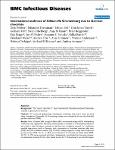International outbreak of Salmonella Oranienburg due to German chocolate.
Werber, Dirk
Dreesman, Johannes
Feil, Fabian
Treeck, Ulrich van
Fell, Gerhard
Ethelberg, Steen
Hauri, Anja M.
Roggentin, Peter
Prager, Rita
Fisher, Ian ST
Behnke, Susanne
Bartelt, Edda
Weise, Ekkehard
Ellis, Andrea
Siitonen, Anja
Andersson, Yvonne
Tschäpe, Helmut
Kramer, Michael H.
Ammon, Andrea
Background: This report describes a large international chocolate-associated Salmonella outbreak originating from Germany. Methods: We conducted epidemiologic investigations including a case-control study, and food safety investigations. Salmonella (S.) Oranienburg isolates were subtyped by the use of pulsed-field gel electrophoresis (PFGE). Results: From 1 October 2001 through 24 March 2002, an estimated excess of 439 S. Oranienburg notifications was registered in Germany. Simultaneously, an increase in S. Oranienburg infections was noted in other European countries in the Enter-net surveillance network. In a multistate matched case-control study in Germany, daily consumption of chocolate (matched odds ratio [MOR]: 4.8; 95% confidence interval [CI]: 1.3-26.5), having shopped at a large chain of discount grocery stores (MOR: 4.2; CI: 1.2-23.0), and consumption of chocolate purchased there (MOR: 5.0; CI: 1.1-47.0) were associated with illness. Subsequently, two brands from the same company, one exclusively produced for that chain, tested positive for S. Oranienburg. In two other European countries and in Canada chocolate from company A was ascertained that also contained S. Oranienburg. Isolates from humans and from chocolates had indistinguishable PFGE profiles. No source or point of contamination was identified. Epidemiological identification of chocolate as a vehicle of infections required two months, and was facilitated by proxy measures. Conclusions: Despite the use of improved production technologies, the chocolate industry continues to carry a small risk of manufacturing Salmonella-containing products. Particularly in diffuse outbreak-settings, clear associations with surrogates of exposure should suffice to trigger public health action. Networks such as Enter-net have become invaluable for facilitating rapid and appropriate management of international outbreaks.
Dateien zu dieser Publikation
Keine Lizenzangabe
Verwandte Publikationen
Anzeige der Publikationen mit ähnlichem Titel, Autor, Urheber und Thema.
-
2013-03-21ZeitschriftenartikelTyping of Salmonella enterica serovar Infantis isolates from 51 outbreaks in Germany between 1974 and 2009 by a novel phage-typing scheme Miller, Tatjana; Braun, Peggy; Fehlhaber, K.; Prager, Rita; Pfeifer, Yvonne; Rabsch, WolfgangWe developed a new phage-typing method and evaluated its application in combination with XbaI macrorestriction analysis by pulsed-field gel electrophoresis (PFGE) as a useful tool for the long-term epidemiology of Salmonella ...
-
2010-05-14ZeitschriftenartikelPork contaminated with Salmonella enterica serovar 4,[5],12:i:-, an emerging health risk for humans. Hauser, Elisabeth; Tietze, Erhard; Helmuth, Reiner; Junker, Ernst; Blank, Kathrin; Prager, Rita; Rabsch, Wolfgang; Appel, Bernd; Fruth, Angelika; Malorny, BurkhardSalmonella enterica subsp. enterica serovar 4,[5],12:i:- is a monophasic variant of S. enterica serovar Typhimurium (antigenic formula 4,[5],12:i:1,2). Worldwide, especially in several European countries and the United ...
-
2013-11-14ZeitschriftenartikelEvidence for the transmission of Salmonella from reptiles to children in Germany, July 2010 to October 2011 Pees, Michael; Rabsch, Wolfgang; Plenz, B.; Fruth, Angelika; Prager, Rita; Simon, Sandra; Schmidt, V.; Münch, Sebastian; Braun, PeggyThis study examines the Salmonella status in reptiles kept in households with children suffering from gastroenteritis due to an exotic Salmonella serovar, to obtain information on possible transmission paths. A number of ...

